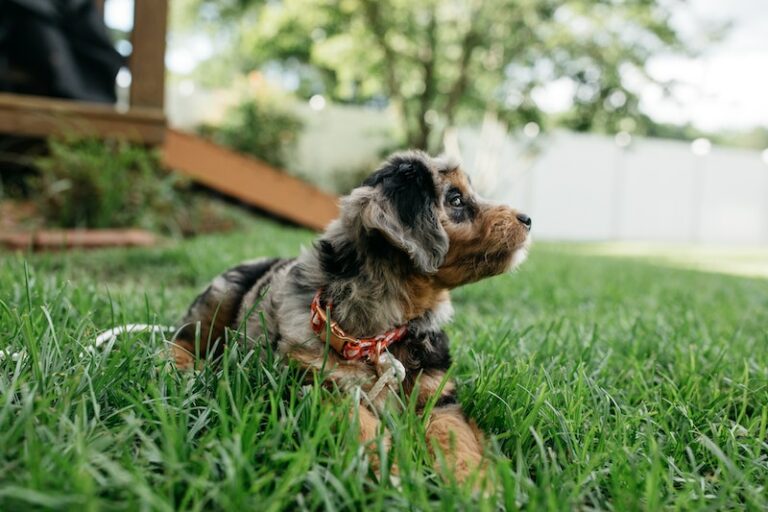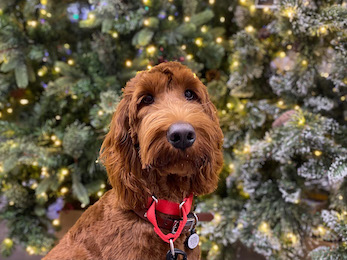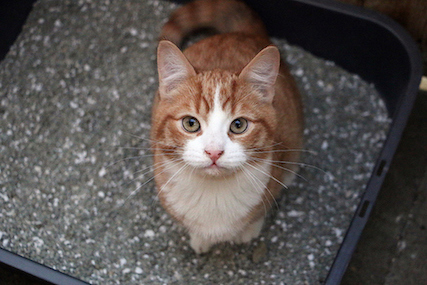My most recent blog covered how to start teaching your puppy obedience behaviors. Using a food lure, you can guide your puppy into nearly any position, which is a great way to use positive reinforcement and avoid force. It is easiest if all obedience behaviors are started in an environment with little to no distractions. Once your puppy masters basic obedience commands in a low-distracting environment, it is time to prepare them for advanced distractions. After all, obedience behaviors are not all that helpful to you or your puppy if they do not apply to your everyday, busy life!
1) Begin Fading Food
One of the first steps to preparing your puppy for advanced distractions is to get the food out of your hands and into a treat bag. That treat bag should be worn on your back so that it is not so apparent to your puppy. Once your puppy can tolerate some delays (i.e., the amount of time it takes to reach into the bag and reward your puppy) in your food delivery without breaking commands regularly, it is time to take the treat bag off and put it on a counter, fireplace mantle, or an out-of-puppy-reach table. Continue to use the bridge word the moment your puppy does the command, but it might take you up to 5 seconds before they get the reward. This will help teach your puppy to start tolerating longer delays in their training.
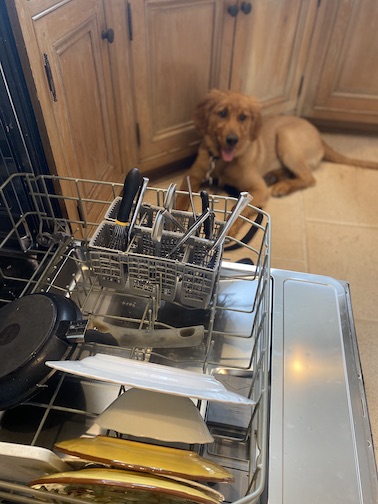
2) Do Normal Activities but Remain Focused on Training
Once your puppy knows a command, it is vital to begin doing normal activities while you train your puppy. If you are practicing a down stay, pretend to check your email or get “distracted” by your phone. Start a load of laundry or begin unloading the dishwasher. Break the everyday activity into bite-sized pieces and reward your puppy at short intervals for holding a command like “stay.” Initially, the pace at which these daily tasks get accomplished might feel like you are getting “help” from a toddler, and you will likely not be getting much done. Still, it is essential to “do” these things while you train your puppy to be prepared to comply with commands during these activities. Consider what behaviors you want them to do as an adult and start teaching them young and at a time when you can remain focused on their behavior—graduate to eating a meal during an otherwise quiet time at home. If at any point you know you will not be able to enforce a command, do not ask your puppy to do the order and if it is a time when problem behavior is likely, put them away. Practice when you can remain focused on training and manage your puppy’s environment in the meantime.
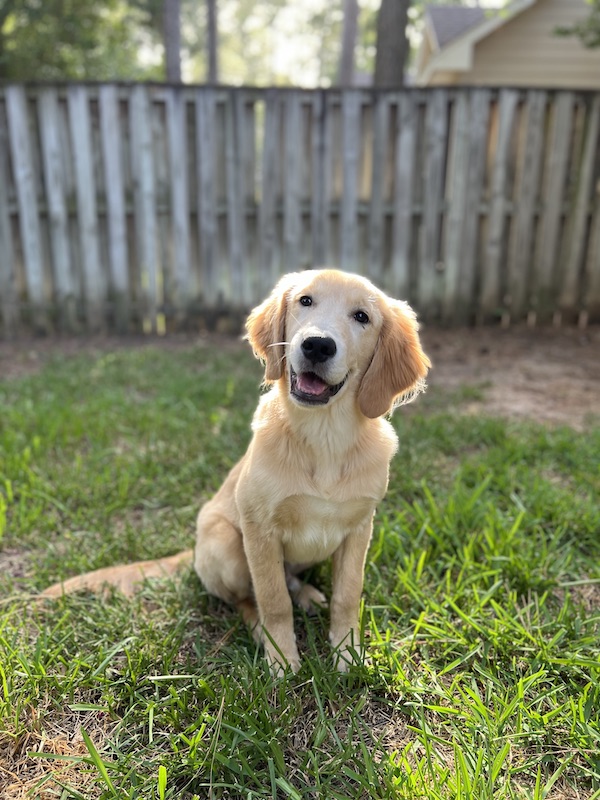
3) Get Your Puppy Practicing Obedience Outdoors
Begin training your puppy outdoors. I recommend starting close to your house and on a concrete area like a driveway. I like to avoid the grass initially because I find it too challenging for most puppies right away. Remember, your puppy’s nose is much better than your nose, and smells can quickly become very distracting.
Go back to the basics you started with when you change environments from indoors to outside. Stay focused for 1-minute intervals and ask your puppy to do an easy behavior like “sit.” Get as many “sits” (with a release) within one minute. As your puppy is successful, begin spacing the prompts out and guiding them around to allow for brief periods of distractions. Take a walk and ask your puppy for low-effort behaviors while out and about.
4) Moving to Advanced Distractions
Steps 1-3 will prepare your puppy for minimal distractions and help lay the groundwork for advanced distractions. Once you have completed those steps, it is time to move on to more advanced distractions! To fully prepare your puppy for advanced distractions, they need to experience those distractions, but only when you can be completely focused on training and your puppy. It is necessary to 1) fade out any signals you do not plan on using every time, 2) teach your puppy to be compliant regardless of what you are doing, and 3) teach your puppy to be compliant regardless of what they are doing.

- To fade out additional signals, ensure your puppy complies with verbal cues. This is important because often, your puppy is not looking at you when you ask them to do a command. By ensuring they know the commands on verbal cues, you can ask them to do a command regardless of where their eyes are. I find it is easiest for your voice to serve as the cue for most commands. If you struggle to get your puppy to learn a verbal command, ensure you have taught them the hand signal first. Once they are reliable on the hand signal, always give the verbal command, pause for a moment, and then deliver the hand signal. Your pause should be brief in the beginning and lengthen over time as your puppy develops the behavior. The goal is to have your puppy “guess” what is coming next and get the correct answer! When they answer correctly, praise heavily and deliver a treat—no need to provide the hand signal. Repeat quickly and begin delaying the hand signal more and more.
- Once you are confident that your puppy knows the verbal command, begin asking them to do the command with you in different positions. Try sitting on the couch and ask your puppy to “sit.” You might be surprised how much standing in front of them is part of the command! Turn your back and ask them to “sit.” Try a yoga pose or ask them while you are brushing your teeth! The goal is to get your puppy to know the command regardless of your actions or your body’s orientation before they hear the command.
- Once your puppy realizes that the command has little to do with the position you are in, it is time to teach them to comply with your command no matter what they are doing. I recommend starting by having your puppy on a leash and allowing them to wander around your house or yard. As soon as they become interested in something, immediately ask them to “sit.” Continue giving them more slack in the leash until they eventually drag the leash and are finally off-leash. You can also vary how long they are interested in whatever they investigate. Allow them to smell or play for longer and longer periods before asking them to comply with a command. You can even take your puppy into distracting environments like your local Home Depot, Lowe’s, or Ace Hardware. Let them become interested in some of the items on the shelf and calmly ask them to “sit.” Continue repeating this process in various settings focusing on the First 5 Commands to Teach a Puppy.
5) Target Problem Behaviors at Difficult Times but Remain Focused on Training
It is essential to teach your puppy to comply with obedience commands around advanced distractions and have excellent manners around them. After all, puppy problem behaviors always seem to occur at the most challenging time! You are too busy or too distracted to use the tools you know work to eliminate the problem behavior. Just like with obedience behaviors, it is easiest to practice at a time when you are prepared and ready for the problem behavior. This can be set up just like the environment for obedience training.

The two most common puppy problem behaviors at distracting times include play biting, and jumping—both attention-getting behaviors. These behaviors happen most frequently when a puppy has been separated from people; if kiddos are involved, they tend to be the most prominent targets of a puppy’s attention-getting behavior! Create times when a family member has been away but at a convenient training time for you. Right after work or school are likely the worst times! Instead, practice after a grocery store run on a Saturday or have kiddos spend time taking a supervised bike ride or walk. Do not exercise your puppy because a wound-up puppy usually engages in plenty of attention-getting behavior! Enter the house alone if your puppy needs to potty. After your puppy has gone potty, instruct your family members to enter, one at a time. This allows repeated practice with new and exciting people each time! When your family reenters the house, make sure your puppy is dragging a leash and be ready because to your puppy, it feels like it has been an eternity since they saw their two-legged buddy! Each person should remain inside for just a minute or two and then leave again. Again, capitalizing on repeated exposures is vital in getting your puppy successful.
As your puppy becomes better mannered, another easy way to bring on problem behavior to help solidify manners around advanced distractions is to encourage jumping or play-biting by having kiddos or other family members get rowdy. Have kids run and play, allowing your puppy to play along, dragging a leash. Reward good behavior when it happens and be ready to intervene when problem behavior occurs. Although your puppy’s behavior will not automatically generalize to times when you are more distracted, creating situations like these does go a long way in saving you effort. Try to remain consistent the first few times when the everyday chaos occurs, and your puppy will learn that the rules are the same regardless of the day.
Teaching your puppy obedience behaviors and manners around advanced distractions is a great way to prepare your puppy for life. To do so, it is essential to make your puppy’s training environment look as close to what everyday life will look like but do it so you can remain focused on your puppy. And remember, go back to the basics for a few minutes anytime you increase the level of distractions. As you progress through these steps, you will have a well-mannered puppy and one that is compliant with commands around advanced distractions without yelling and screaming from you. What a great way to continue strengthening your bond with your puppy and teach them in the meantime!
